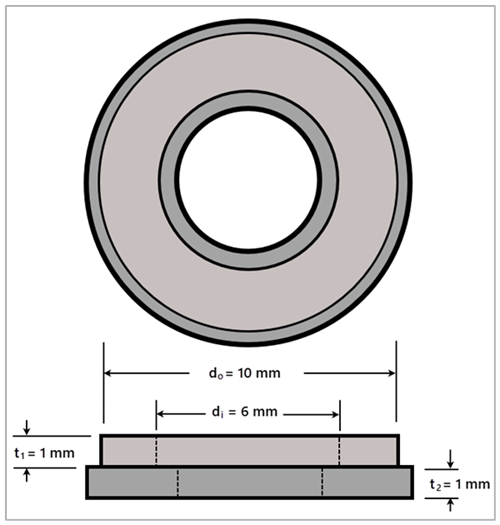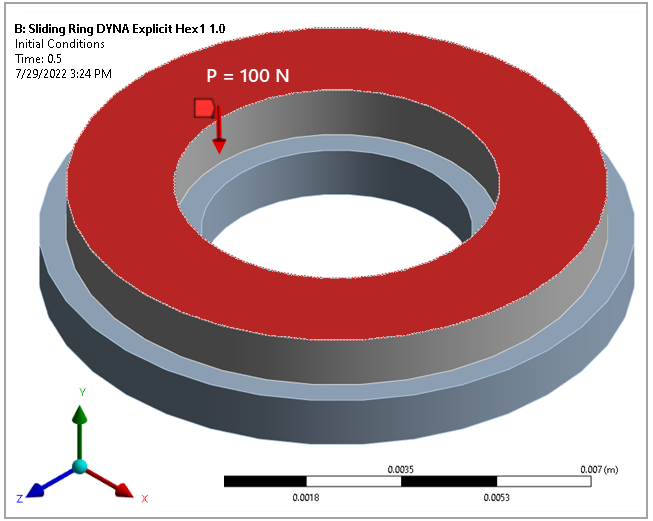VM-LSDYNA-BENCHMARK-006
VM-LSDYNA-BENCHMARK-006
Torque Required to Overcome Friction in a Sliding Ring
Overview
| Reference: | Juvinall, R.C. & Marshek, K.M. (Eds.). (1991). Fundamentals of machine component design. John Wiley & Sons, p. 677. |
| Analysis Type(s): | Explicit Dynamics with Workbench LS-DYNA |
| Element Type(s): | Solid |
| Input Files | Link to Input Files Download Page |
Test Case
A vertical force is applied to a solid ring under constant rotation while in frictional contact with a fixed platform. A linearly elastic, isotropic material model is used for the disc and platform, with a Young's modulus (E) of 200 GPa and Poisson's ratio of 0.3. The coefficient of friction (µ) is 0.4.
Determine the required torque to rotate the ring.
| Material Properties | Geometric Properties | Loading |
|---|---|---|
|
E = 200 GPa ν = 0.3 |
di = 6 mm do = 10 mm t1 = 1 mm t2 = 1 mm |
P = 100 N |
Analysis Assumptions and Modeling Notes
The closed form solution equations for normal stress in the y-direction (σy), shear stress in the xy-direction (τxy), maximum principal stress (σmax), and minimum principal stress (σmin) at point H are as follows:
(40) |
Using a coefficient of friction (µ) of 0.4 and substituting for the given values above (noting that r = D/2), T = 163.3 Nmm.
For the LS-DYNA Explicit simulations using the Penalty (SOFT = 0) contact, it was found that the torque result depended on the speed of rotation. Therefore, a time convergence study was conducted to determine the speed below which the torque would be the same (not shown). Due to the slow converged rate (1°/second, the simulation was carried out with three intervals of 0.1°/0.1 seconds separated by one interval of 5°/0.1 seconds and one interval of 10°/0.1 seconds to check the torque result across a wider range of motion. Only results from the three 0.1°/0.1 second intervals were used in the final torque assessment (averaged).
The contact was AUTOMATIC_SURFACE_TO_SURFACE, and the static and dynamic coefficients of friction were the same (0.4).
Penalty
End Time: 0.5 sec
0 to 0.005 sec: Force ramped to 100 N, no rotation
0.005 to 0.1 sec: Constant 100 N force, 0.1° rotation
0.1 to 0.2 sec: Constant 100 N force, 5° rotation
0.2 to 0.3 sec: Constant 100 N force, 0.1° rotation
0.3 to 0.4 sec: Constant 100 N force, 10° rotation
0.4 to 0.5 sec: Constant 100 N force, 0.1° rotation
The element used was LS-DYNA Explicit Hex 1 with an element size of 1 mm.
Comparison values are reported for the Windows 11 platform.




